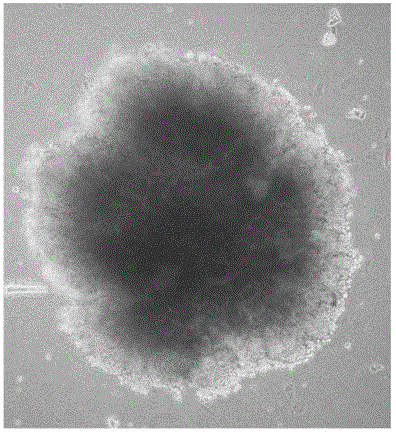Method for preparing monoclonal hybrid tumors
A monoclonal, hybridoma cell technology, applied in the biological field, can solve the problems of large workload, obstacles, and complicated operation of cell culture, and achieve the effects of avoiding low survival rate, reducing production cost and simple preparation method.
- Summary
- Abstract
- Description
- Claims
- Application Information
AI Technical Summary
Problems solved by technology
Method used
Image
Examples
Embodiment 1
[0072] Example 1 Preparation of cloned hybridoma cells.
[0073] 1. Fusion:
[0074] Take splenocytes and sp2 / 0 cells in a good state after conventional immunization, control the ratio of splenocytes and sp2 / 0 cells at 5:1, and use PEG 4000 with a volume fraction of 50% for fusion; alternatively, The ratio of the number of splenocytes to sp2 / 0 cells can be controlled between (10-2):1, and PEG with a molecular weight in the range of 1000-6000 can also be selected.
[0075] The fused cells were cultured in a 5-7% carbon dioxide incubator at 37 degrees for 16 hours using 20% fetal bovine serum culture medium.
[0076] 2. Cultivate:
[0077] Gently blow off the hybridoma cells and centrifuge to pellet, resuspend in 5-10mL conventional HAT liquid medium with a volume percentage of 2% HAT, then use the above medium to make up to 120mL, and distribute to 6 96-well plates medium, 200 μL / well; culture in a 5-7% carbon dioxide incubator at 37°C for 7 days, and then use HAT medium f...
Embodiment 2
[0113] Example 2 Preparation of cloned hybridoma cells.
[0114] 1. Fusion:
[0115] Take the splenocytes of mice after routine immunization and NS-1 cells in good condition, control the ratio of the number of splenocytes and NS-1 cells at 10:1, and use PEG 1000 with a volume fraction of 60% to fuse; alternatively, The ratio of the number of splenocytes to NS-1 cells can be controlled between (10-2):1, and PEG with a molecular weight in the range of 1000-6000 can also be selected. The fused cells were cultured in a 5-7% carbon dioxide incubator at 25 degrees for 24 hours using 15% fetal calf serum culture medium.
[0116] 2. Cultivate:
[0117] Gently blow down the hybridoma cells and centrifuge to pellet, resuspend in 5-10mL conventional HAT liquid medium with a volume percentage of 5% HAT, then use the above medium to make up to 120mL, and distribute to 6 96-well plates medium, 200 μL / well; culture in a 5-7% carbon dioxide incubator at 25°C for 7 days, and then use HAT me...
Embodiment 3
[0127] Example 3 Preparation of cloned hybridoma cells.
[0128] 1. Fusion:
[0129] Take splenocytes and sp2 / 0 cells in a good state after routine immunization, control the ratio of splenocytes and sp2 / 0 cells at 2:1, and use PEG 6000 with a volume fraction of 40% to fuse; alternatively, The ratio of the number of splenocytes to sp2 / 0 cells can be controlled between (10-2):1, and PEG with a molecular weight in the range of 1000-6000 can also be selected. The fused cells were cultured for 20 hours in a 5-7% carbon dioxide incubator at 30 degrees using 10% fetal bovine serum culture medium.
[0130] 2. Cultivate:
[0131] Gently blow off the hybridoma cells and centrifuge to pellet, resuspend in 5-10mL conventional HAT liquid medium with a volume percentage of 4% HAT, then use the above medium to make up to 120mL, and distribute to 6 96-well plates medium, 200 μL / well; culture in a 5-7% carbon dioxide incubator at 30°C for 5 days, and then use HAT medium for full replacement...
PUM
 Login to View More
Login to View More Abstract
Description
Claims
Application Information
 Login to View More
Login to View More - R&D Engineer
- R&D Manager
- IP Professional
- Industry Leading Data Capabilities
- Powerful AI technology
- Patent DNA Extraction
Browse by: Latest US Patents, China's latest patents, Technical Efficacy Thesaurus, Application Domain, Technology Topic, Popular Technical Reports.
© 2024 PatSnap. All rights reserved.Legal|Privacy policy|Modern Slavery Act Transparency Statement|Sitemap|About US| Contact US: help@patsnap.com










